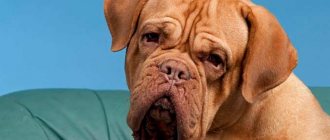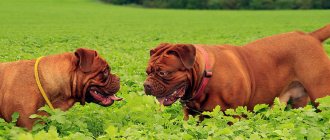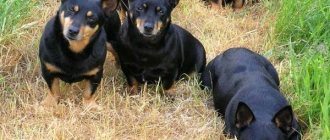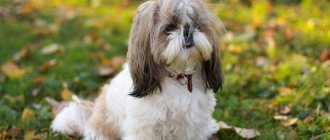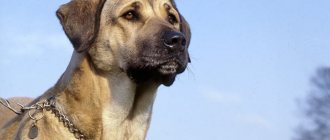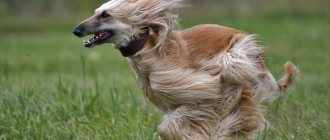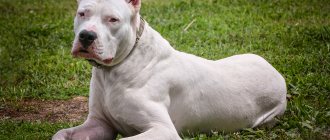Description and features
The Dogue de Bordeaux breed has a second, more popular name - French Mastiff. This is a strong and slightly frightening-looking dog, which often appears in films and TV series. Unfortunately, its reputation leaves much to be desired.
In cinema, the dog is often shown as a negative character, evil and treacherous. But this image is completely out of character for him. The French Mastiff is the cutest creature on earth!
If we talk about the animal’s temperament, then it is phlegmatic. It is quite silent, reserved and cold-blooded. However, in some situations, it can behave like a choleric person, barking loudly, being aggressive and moving jerkily. But this only happens in case of a real threat.
Interesting ! Biologists and animal psychologists say that benign aggression is common among some mammals, including dogs. Previously it was believed that it was unique to humans. This concept implies the aggravation of a defense mechanism in order to preserve oneself and one's fellow humans.
The Dogue de Bordeaux is an excellent watchdog. He is alert, careful, attentive and focused. Even if the dog is relaxed, he does not stop carefully observing the territory. He lies down or sleeps most of the day, so he tends to be overweight. However, if an unfamiliar animal or person tries to enter his house, he will immediately attack him.
Don't underestimate the strength of this dog! When attacked, it can cause serious physical harm to a person. Some dog handlers specifically train representatives of the breed so that they become more angry and intolerant of people. This is not necessary, because nature initially endowed the mastiff with excellent protective potential.
Previously, European police made attempts to train Dogues de Bordeaux on criminals. However, they were not effective. Why? It's all about the famous explosive nature of these animals.
Yes, they are phlegmatic, calm and balanced, but if there is a threat (and in the police service it arises regularly) they fly into a rage. Of course, a service dog cannot cause harm to a person, even a fugitive or a dangerous criminal. Since representatives of this breed are ineffective in this regard.
It is very difficult to control the frantic energy of such a dog. He often becomes uncontrollable, especially if he has not been raised since early childhood. By the way, the breed was first formed in France.
Pros and cons of the breed
Positive qualities of Dogue de Bordeaux
- Original appearance.
- Ability to perform security and watchdog functions.
- Devotion to the owner.
- High level of intelligence.
Negative traits of the breed include
- Aggression towards people and animals that occurs due to insufficiently strict upbringing.
- Significant dimensions of the animal.
- High cost of puppies.
- Loud snoring during sleep and intense salivation.
- Significant cost of owning a dog.
Breed standard
Mastiffs were brought into Russia only in 1990. At the same time, a demonstration dog show was organized here for the first time, at which 5 such dogs were presented. Since then, no changes have been made to standardization. The Dogue de Bordeaux in the photo looks like a powerful monster. It is very large, weighing from 81 to 90 kg and tall, with a height of 62 to 68 cm. Females are smaller in weight and height than males.
The dog's physique is stocky, strong and harmonious. He has a wide rectangular back. The lower back is convex. The tail is recumbent. It is long and wide, thickened at the base. The front legs are short, the hind legs are longer.
The thigh muscles are very powerful. The dog needs them for a quick push from the ground. The belly is slightly sunken and the ribs are not visible. The chest is very powerful and wide. The neck is of medium length. But the mastiff’s head is huge.
He has thick, drooping cheeks. A large nose at the edge of the muzzle, tiny light eyes hidden under the upper folds of skin, small triangular ears. The peculiarity of the breed is the lower jaw that moves forward, but the bite of its representatives is correct. According to the standard, only 1 shade of fur is acceptable (for mastiffs it is short) - red. But there are a lot of shades. The dog may be:
- Light red.
- Kashtanova.
- Dark brown.
- Sand beige.
- Yellowish, etc.
There should be no stripes, spots or brindles on the body of a Dogue de Bordeaux dog If they are present, it will not be considered high-breed. The exception is the center of the sternum, there may be a small white spot there. Only solid color is standardized. But, on the face of such animals there must be a “mask”; usually it is darker than the main color of the body.
The animal's coat is very thick, but each of the hairs is thin. But, due to the fact that they fit tightly to each other, it seems that the mastiff has a fluffy coat. By the way, he has thick skin, so in different parts of the body, mainly the muzzle, it forms an “accordion”; in other words, folds are visible there.
Pit bull terrier
The character of these powerful, strong-willed animals is determined by the mixture of breeds from which they were bred: bulldog and terrier. From the first they received strength and perseverance, from the second they received speed of reaction and agility. Combined with an independent disposition, these qualities made the pit bull a devastating fighting machine for spectacular dog fights.
Dog fighting was at one time very common in the United States, and pit bulls became very popular there, although the official canine association never recognized this breed due to the “blurring” of its standard. Then, when fighting was banned, such dogs began to be kept at home as service dogs. However, due to their aggressiveness and uncontrollability, a ban on their breeding was introduced in a number of countries: pit bulls often attacked people.
Currently, dogs of this breed are valued for their keen sense of smell and are actively used by police and customs services to search for drugs and explosives.
Character
The French Mastiff gives the impression of a scary dog with a huge head and a powerful jaw. Just the sight of him makes your blood run cold. But it’s not for nothing that people say that appearances are deceiving.
By nature, this dog is friendly, and with every member of its pack. She quickly becomes attached to them, develops trust and becomes vulnerable in her love. Those who keep such animals in the house for a long time claim that they cannot find a sweeter and kinder pet.
Is it so? In part, the loving owners of Dogues de Bordeaux are right. However, we should never forget that this is a fighting breed with natural guarding potential. Therefore, its representatives, although friendly and pretty at home, can still behave unpredictably.
Important ! Owning a mastiff is recommended only to experienced dog breeders. This is a serious breed that needs constant monitoring and attention. Such a dog cannot be called cheerful and energetic. By temperament he is phlegmatic. He is characterized by the following features:
- Slowness.
- Inactivity.
- Good observation.
- Emotional restraint.
- Sociability.
It's hard to believe, but these wrinkly big guys are very affectionate. They love their family members so much that they are ready to devote their lives to protecting them. Mastiffs treat children especially carefully.
They are affectionate with them and behave carefully when around them. Never forget about their protective functions. Small children are protected from strangers and loud noises. They lie down next to them and fall asleep, but do not lose their vigilance.
The main trait of the domestic Great Dane is loyalty. He chooses only one leader, to whom he is endlessly loyal. Usually, it becomes a mature man. Such a dog will never serve a weak-willed person who has a number of complexes. He will choose as his patron only a strong-willed and purposeful person who leads by nature.
The mastiff is never separated from its owner even for a minute. He prefers to be nearby so that in case of trouble he can come to the rescue. Can't stand long separation. If the owner leaves the dog alone for a long time, he becomes sad and may even stop eating.
Do not forget that the Dogue de Bordeaux, despite its bodyguard skills, is still not a guard breed. Therefore, if he has to let an unfamiliar guest into the house, he will first sniff him and even try to make friends. He will not bark loudly at a stranger.
Despite his strong love and devotion to his owner, he never allows him to completely dominate him. Submits, with strong respect, but reluctantly. Prefers to maintain self-esteem, so it needs serious training.
It gets along well with other domestic animals only with early and joint socialization. Can be affable and friendly even with a cat. Such a dog has an interesting character trait - nobility. She patronizes every living creature living with her under the same roof.
This means that if someone attacks a kitten living with a Dogue de Bordeaux in the same house, it will certainly fight back and protect it. And these dogs are also very stubborn. They quickly identify their master's weakness and skillfully take advantage of it. Mastiff is such a manipulator!
Fila Brasileiro
The power of a mastiff, the sad charm of a bloodhound, the stubbornness of a bulldog - all this is Fila Brasileiro. Modern dogs of this breed are extremely intelligent and devoted to their family. Experts talk about them as excellent security guards for a country house. They are also considered excellent companions. How, with all its undoubted advantages, did this wonderful dog get into our rating?
It turns out that she is only good for “her own people.” “Aliens” do not go where the phyla are kept. On the gates of mansions and country houses in Brazil you will not find signs “Beware of the evil dog!” There is one word written very specifically in large letters: “FILA.” This is enough for not a single robber to even look towards the estate.
The fact is that in this breed, hostility towards strangers is fixed at the genetic level. Considering the size of the Fila, its keen sense of smell and excellent agility for its size, it is difficult to imagine what could stop it if it decides to show its protective instinct. That is why in a number of countries keeping such dogs is allowed only by court decision.
This is what the ranking of the scariest dogs looks like. However, experienced dog handlers, when asked which dog is the most dangerous, answer: “The one that was poorly raised by the owner.” So, before you get a puppy, think about whether you have enough time and energy to properly raise a human friend?
Maintenance and care
The Dogue de Bordeaux's sense of territoriality, despite its watchdog potential, is poorly developed. It is advisable to exploit him as a bodyguard and protector of people. This is why such a dog can be kept indoors and not outdoors. Yes, she is massive, but also sedentary and neat. She definitely won’t cause any problems or excessive household troubles.
Sometimes caring mastiff owners kindly ask them to spend the summer outside. For an adult pet dog, accustomed to living in a house, such a request will come as a shock. He'll probably be upset.
However, a long stay in the fresh air will definitely not harm him. Regardless of where you live, try to go for walks together more often. The dog must understand that its owner will be there in case of danger, this will allow it to develop self-confidence.
This animal does not like to run or rush around the yard after birds and insects. It would rather lie down in the sun to take a nap. But, you should not allow a large dog prone to obesity to be in a relaxed state all the time.
Invite her to do sports together, such as running in the morning. A simpler option is to play catch or “fetch the ball.” Help your pet always keep his body in good shape and control his weight gain.
Now let's talk about caring for the French Mastiff. Here are some tips:
- Combing. These dogs shed every year. You will need a massage brush or comb. Invite the animal to sit down so that you can comb it over the entire surface of its body.
- Examination of the ears. Inspect your pet's ears every day, especially if he lives outside, as there may be mites infested there. This is also required to prevent inflammation. If your dog's ears are covered in wax, clean them.
- Dental examination. The easiest option for caring for your pet dog’s oral cavity is to regularly buy him a stringy stick. He will happily chew on it, thereby ridding himself of plaque.
- Eye cleaning. You should wash your mastiff's face at least once a week.
- Rubbing the folds on the muzzle. Unfortunately, large dogs often eat sloppily, so you should wash their face or wipe it with a damp cloth or napkin.
- Removing drool. In such animals, severe salivation occurs from the mouth. The liquid can drip onto the floor, furniture and even the dining table. You can remove saliva with a damp cloth.
It is not necessary to bathe your shorthaired Dogue de Bordeaux. He takes care of his own hygiene. You can clean it using the dry method. But if it gives off an unpleasant smell, you can’t do without bathing.
Advice ! When walking your French Mastiff, make sure he doesn't get thirsty. If your dog is drooling a lot from his mouth, he is probably thirsty. Give her some water.
Caring for Dogue de Bordeaux
Bordeaux are not suitable for year-round outdoor or enclosure keeping, because a short coat will not warm you up in the cold season. Dogs will be most comfortable in an apartment or house, but the area should be sufficient for a large pet. Mastiffs do not need long walks and serious physical activity. Moreover, Great Dane puppies must even be limited in physical activity, otherwise disturbances in the development of the musculoskeletal system are possible.
It is best for Dogues de Bordeaux to live in an apartment or house.
Regular care is as follows:
- weekly combing with a special rubber mitten to remove dead hairs (during shedding, this is done more often);
- bathing as needed (about once every 2-3 months) using zoo shampoos for short-haired dogs;
- examining the eyes (daily) and ears (weekly), as well as cleaning them with veterinary lotions;
- trimming claws (monthly), if they do not grind down on their own;
- brushing your teeth with a special brush (finger attachment) and toothpaste that does not need to be rinsed off;
- cleansing and washing all folds on the face (after walks and meals) using a decoction of herbs or clean boiled water to avoid the accumulation of dirt and the development of infection.
You can feed Bordeaux dogs with factory-made freeze-dried formulas of at least premium class (Acana, Brit, etc.) or freshly prepared homemade food. Adults are kept on two meals a day; puppies are given food more often (3 to 6 times a day).
The unique dry food ACANA HERITAGE ADULT LARGE BREED for large breed dogs weighing more than 25 kg contains 60% meat ingredients, which makes the diet rich in proteins necessary for muscle development
To create a natural diet use:
- lean meat (veal, horse meat, turkey, etc.);
- offal and entrails (cartilage, tripe, kidneys, etc.);
- boiled fish (oceanic);
- raw and boiled eggs;
- fermented milk (cottage cheese, yogurt, etc.) with low fat content;
- boiled and raw vegetables;
- porridge (oatmeal, rice, etc.);
- fruits, greens;
- unrefined vegetable oil and vitamin and mineral supplements.
It is forbidden to give Great Danes pastries, canned food, sweets (especially chocolate), as well as smoked, fried, fatty and tubular bones (chicken, turkey, etc.).
The neighbors on the landing have a female Dogue de Bordeaux living in their apartment. She is now about five years old. When she was little, she was carried for walks in her arms so that her young bones would not become bent when going up or down the stairs. Towels are placed throughout all rooms to wipe away the drool that flows profusely from the mouth. The breed is very specific, but the character is really soft and friendly. I have never seen this dog growl or bark. It is enough for her to simply look from under her brows to intimidate any violator of the boundaries of her entrusted territory.
Training
You need to start raising a little Bordeaux as early as possible; kids quickly understand what is required of them and remember the simplest commands. Training can be a challenge because Bordeaux Mastiffs are stubborn, slow, and tend to be lazy. In addition, they quickly get tired of long lessons; the lesson should last no more than an hour. When working with this breed, consistency and constancy are important; training cannot be interrupted for a long time.
French Mastiffs need to be trained
It is recommended to use the help of an experienced instructor, but do not completely entrust the training of your pet to him, but only use professional advice.
Nutrition
Let's start with the main thing - Dogues de Bordeaux eat a lot. They are large, so they need a decent portion of carbohydrates and proteins. Since such a dog moves little, it can easily become fat. Therefore, we recommend feeding her 2, or preferably 3 times a day. For 1 meal she needs to eat from 500 to 600 grams of food. This can be natural food or industrial feed.
Few people give such huge dogs natural food on a regular basis, because this is problematic. Therefore, most owners opt for a ready-made diet for their pets. A Dogue de Bordeaux puppy should gain more than 10 kg in the first months of life. Therefore, in addition to dry food, his menu must include:
- Cottage cheese.
- Low-fat soup.
- Boiled meat and fish.
- Vegetables and fruits.
- Berries.
You can also additionally give him boiled eggs, pasta, borscht and offal (liver, heart, lungs, etc.). This food is rich in protein and microelements that a young dog’s body needs. After he reaches 7-8 months, all this food can be eliminated from his diet. Give him dry food rich in vitamins every day. Don't skimp on it!
Reproduction and lifespan
These powerful dogs serve from 8 to 11 years. The healthier the dog, the longer he lives. Therefore, always monitor your pet’s health. Remember that only hardy, mentally stable and strong mastiffs that meet the breed standard are allowed to breed.
The first heat in female dogs occurs between 9 and 12 months. But at this stage it is impossible to bring her together with a male Great Dane. The young dog cannot bear and will not give birth to healthy puppies. Therefore, a female over 2 years old should be used for breeding. She must show sexual interest in the male and not push him away.
As for the male, he reaches the age of sexual maturity much earlier, at about 4 months of age. But, in his case, the rule for mating is similar. The breeder must select a high-breed male over 2-2.5 years old.
How to choose a puppy
Before buying a puppy, the future owner should carefully study the breed standard. Next, you should find a nursery that has a good reputation and recommendations. Ask the breeder to present all the necessary documents (pedigree, veterinary passport, diplomas, certificates). After this, you should examine the puppies and get to know them.
- The dog should not show aggression or be excessively lethargic.
- The animal's skin, eyes and ears must be clean.
- Be sure to examine the puppy's oral cavity.
- The lower jaw should be pushed forward.
- If you don't see a snack, it's best to choose another puppy.
Price
The French Mastiff is a fairly expensive breed. The dog is considered prestigious. There are nurseries in which such animals are bred in almost every capital of the CIS countries, including Moscow and Kyiv.
The minimum price for Dogue de Bordeaux in Russia for 2019 is 25 thousand rubles. But, for such a price you definitely won’t buy a high-breed puppy with a pedigree. To become the owner of a show-class dog that can be registered at exhibitions, you will have to pay twice as much, at least 50 thousand rubles.
History of the origin of the Dogue de Bordeaux
The Dogue de Bordeaux takes its origins from the French mastiffs; this breed was specially bred for hunting. Mastiffs were very strong, massive, strong. They easily dealt with large game, including wild bulls, moose and bears. In this way, the breed was able to survive until the First World War, during which it began to be used for fighting.
The Dogue de Bordeaux began its origins in Aquitaine, with the blood of Molossians, Alans and Hunnic dogs flowing in it. People carefully developed the breed, thereby increasing the population of red giants. Many sources indicate that dogs of this breed were used in many major battles; the dogs were excellent fighters.
At the same time, Great Britain bred its own giant breed, which was considered the property of England. The English mastiff - strong, fearless - was considered an indicator of high status among the British.
Dogue de Bordeaux dog
As a result of diplomatic relations between France and England, Great Britain gave many English mastiffs to the French as gifts. The French began to associate the “French” with the “English,” which finally formed the image of the Dogue de Bordeaux.
In 1789, the French Revolution began, which claimed a large number of human and dog lives. The dogs were taken away by people who fled to escape death. So the Dogue de Bordeaux got lost among dogs, but, surprisingly, the breed did not disappear. People used Great Danes as beasts of burden, carrying carts filled with the bodies of cattle to market. Brutal dog fights were organized for entertainment and profit. Bloodthirstiness itself prompted people to breed purebred dogs to create “ultimate murder weapons.”
Dogues de Bordeaux were used in dog fighting
The destruction of the Great Dane breed continued until the mid-18th century. It was then that the demand for powerful, fearless dogs that could attack wild animals and fight among themselves increased. Only this bloodthirsty hobby prevented the Dogue de Bordeaux breed from being destroyed once again. They carefully tried to preserve the Great Danes during the Second World War. Some breeders managed to register only a few dogs of pure blood; they raised and kept their pets themselves. It was only in the 70s that the breed was recognized by the FCI.
This is interesting! This dog breed became famous after the release of the movie Turner and Hooch.
In modern times, the breed became famous after the movie “Turner and Hooch”
Education and training
The owner of such an animal should be aware of its inactivity and fatigue. Yes, it is incredibly savvy and smart, but it needs breaks between workouts.
First, teach your baby mastiff his name. He should always come when you call. Repeat the dog's name in his presence. Let everyone in the household do the same. By 2-3 days he will remember it.
The second thing a puppy of this breed must learn is that there is room for command. The dog must have a separate sleeping place, where it will go at the request of the owner or any member of his family. Lead the animal to the desired point and say loudly and clearly: “Place!” Give him a gentle pat on the head if he goes there on his own. This will ensure your success in his training.
By the way, since we're talking about encouragement. Reward your pet as often as possible! This motivates him very well. And of course, the basic rule for training Dogue de Bordeaux is short training. The dog quickly loses interest in the material and may become absent-minded.
Reward her not only with treats, but also with compliments. Let her feel that you value her and love her. She shouldn't be afraid of you! A dog of this breed that is aggressive towards a person will never listen to him. She will try to defend herself if you threaten her.
Some male mastiffs tend to be dominant. They often refuse to follow commands and can manipulate. Therefore, we advise you to initially build a trusting relationship with them. If the dog treats you with trust, strives to accompany you everywhere and comes when called, know that you have built a bridge to his heart.
Another important point is that the representative of the breed has excellent memorization skills, so use this during his training. Repeat one command several times, try to repeat it at regular intervals.
Monitor your Dogue de Bordeaux while walking. He should not pull the leash forward, he should walk next to the owner and rely completely on him. To teach this, train from an early age! Use a strong collar and leash.
Be the first to exit the yard door, only then inviting your pet to follow you. Stop it if you decide to end your walk. When animals appear nearby, wrap your hand in a leash and pull it tight so that the dog does not decide to start breaking out.
Buying a puppy: price, documents, advice on choosing
When you have already chosen the Dogue de Bordeaux breed and decided to purchase a puppy, then, first of all, you need to decide what gender of animal you need and for what purpose you are making the purchase. As mentioned above, there are three exterior classes. The greater the compliance with the standard, the higher the price of the puppy will be. When choosing a dog among pet puppies, you do not need to show any special knowledge, the main thing is to have an idea of what a dog of a given breed should be like. If your attention is focused on choosing a dog of breeding and show classes, then you need to have a good knowledge of the standard. Dogs of these classes have a high cost, so knowledge of the standard will come in handy. It’s even better to get advice from an expert in the field of this breed in order to avoid mistakes and become a victim of deception. The most ideal option is to visit the nursery together with an expert.
What gender should I choose for my puppy? Here you make the choice yourself. When choosing a bitch, it is worth considering that they are very obedient, but they are not deprived of cunning; they should not be allowed to go for a walk without a leash during estrus, and this is at least 2 times a year. Leadership needs to be established over male dogs, which requires some effort. Also, male dogs often show dominance towards other dogs of the same sex, and when a female dog in heat is nearby, this worsens their behavior.
Dogue de Bordeaux puppies
Having chosen the gender of the puppy and made sure that it corresponds to the declared class, you can view the availability of nurseries of this breed and choose a responsible and conscientious breeder. This is a very important step towards purchasing a pet, because the quality of the breed depends on the qualifications and integrity of the breeder.
How can you find out how conscientious a breeder is? Here you can draw conclusions from a conversation with a person. The breeder will have a lot of questions for you, he will be interested in where and how the puppy will live, whether the owner can spend a lot of time with the animal, how much time the owner is going to spend walking the dog, that is, the breeder will be interested in: he needs to make sure that Will the puppy get into safe hands? The question may also arise about the room: how spacious, clean and light it is. The breeder will always be able to answer any questions from the buyer, provide the necessary documents, and advice on raising and feeding the puppy after purchase. The specialist will show the breeders and tell you about all the conformation deviations of the selected dog. All dogs have veterinary passports with age-appropriate vaccinations, done with a delay of no more than 10 days. No less important criteria for a good breeder are breeding no more than two breeds; puppies leave the nursery no earlier than three months of age.
Description of the Dogue de Bordeaux breed
Never purchase a puppy over the Internet if the owner only has photos and you have only talked on the phone. You definitely need to visit the nursery, or even better, more than once, to be sure of the integrity of the breeder and the quality of the breed. When visiting, look at the bitch, make sure that she is the mother of the puppy you want to purchase, look at the photo and video of the dog. Also review the documentation for the female and male (pedigree, diploma, veterinary passport, tests for dysplasia). You also need to review the documentation for the puppy so that everything is documented in the veterinary passport and puppy card. Be sure to examine the puppy before purchasing; it must be in excellent physical shape without psychological abnormalities. The animal should not be aggressive or injured. The puppy should be active and not overexcited. You need to get detailed advice from the breeder on the breed and find out about the health status of the animals in the nursery. Check the vaccination dates in your passport - do not pick up your puppy earlier than 10 days after vaccination, he must undergo quarantine.
Video - Description of the Dogue de Bordeaux breed
Puppy documents
The breeder is obliged, along with the puppy, to hand over a puppy card - a birth certificate (required by the Russian Canine Federation, without it it is impossible to register a pedigree in an international format) and a veterinary passport (availability of information on age-related vaccinations). Be sure to check that the name on the puppy card and the veterinary passport match!
This is interesting! The absence of a pedigree from the RKF completely excludes the possibility of participation in exhibitions of this organization and in performances at an international level.
Let us immediately inform the buyer: they do not immediately provide a pedigree with the puppy, this is due to the fact that the owner’s full name is indicated in the pedigree, that is, when you purchase the puppy, only then will it be possible to draw up this document.
If you purchase a puppy in another city, you must obtain an F1 certificate for hassle-free transportation of your pet on any transport. The buyer is also provided with a copy of the purchase and sale agreement and the acceptance certificate with signatures.
When choosing a puppy, be careful and carefully check all documents
Possible diseases and methods of treating them
The Dogue de Bordeaux is a healthy and hardy dog, but due to improper care it may end up at the veterinarian with a diagnosis of hip dysplasia. Also, some representatives of the breed face oncology.
According to experts, the risk of cancer in dogs increases due to an unbalanced diet. It should be noted that most French mastiffs are prone to allergies. It is provoked mainly by low-quality food.
Well, the last point regarding the health of these large dogs is difficult childbirth. Dogue de Bordeaux puppies have a voluminous head, which is not easy for the bitch to push through during contractions. Therefore, it is very important that a veterinarian attend the birth. Give your pets special vitamins to maintain immune protection. Don't forget to take them to the veterinary clinic for vaccinations!
Dogue de Bordeaux kennels
When choosing a puppy, first of all, focus on the quality of the breed; for this, contact only specialized nurseries. It is there that you can get the necessary advice from experienced breeders on raising and maintaining your future pet. Only in nurseries are all rules of care and feeding observed, and they also serve as a guarantee of the quality of the breed of your future pet.
- "The Tsar's Idyll", Moscow;
- "VelcomSetan", Novosibirsk;
- "AvantRux", Moscow;
- God Bless.Rybinsk;
- "Dorsdorf", Moscow.
Buy Dogue de Bordeaux in specialized nurseries from experienced breeders
